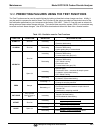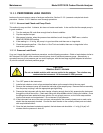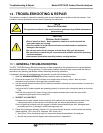
Maintenance Model GFC7001E Carbon Dioxide Analyzer
Teledyne Analytical Instruments 265
12.3.3. PERFORMING LEAK CHECKS
Leaks are the most common cause of analyzer malfunction; Section 12.3.3.1 presents a simple leak check
procedure. Section 12.3.3.2 details a more thorough procedure.
12.3.3.1. Vacuum Leak Check and Pump Check
This method is easy and fast. It detects, but does not locate most leaks. It also verifies that the sample pump is
in good condition.
1. Turn the analyzer ON, and allow enough time for flows to stabilize.
2. Cap the sample inlet port.
3. After several minutes, when the pressure has stabilized, scroll through the TEST menu, note the
SAMPLE PRESSURE reading.
4. If the reading is < 10 in-Hg, the pump is in good condition and there are no large leaks.
5. Check the sample gas flow. If the flow is <10 cm
3
/min and stable, there are no large leaks in the
instrument’s pneumatics.
12.3.3.2. Pressure Leak Check
If you can’t locate the leak by the above procedure, use the following procedure. Obtain a leak checker similar to
the Teledyne P/N 01960, which contains a small pump, shut-off valve and pressure gauge. Alternatively, a
convenient source of low-pressure gas is a tank of span gas, with the two-stage regulator adjusted to less than
15 psi with a shutoff valve and pressure gauge.
CAUTION
GENERAL SAFETY HAZARD
Do not use bubble solution with vacuum applied to the analyzer. The solution may
contaminate the instrument. Do not exceed 15 PSIG pressure.
6. Turn OFF power to the instrument.
7. Install a leak checker or tank of gas as described above on the sample inlet at the rear panel.
8. Remove the instrument cover and locate the inlet side of the sample pump. Remove the flow assembly
from the pump and plug it with the appropriate gas-tight fitting.
9. Pressurize the instrument with the leak checker, allowing enough time to fully pressurize the instrument
through the critical flow orifice. Check each fitting with soap bubble solution, looking for bubbles. Once
the fittings have been wetted with soap solution, do not re-apply vacuum, as it will suck soap solution
into the instrument and contaminate it. Do not exceed 15 psi pressure.
10. If the instrument has one of the zero and span valve options, the normally closed ports on each valve
should also be separately checked. Connect the leak checker to the normally closed ports and check
with soap bubble solution.
11. Once the leak has been located and repaired, the leak-down rate should be < 1 in-Hg (0.4 psi) in 5
minutes after the pressure is shut off.


















